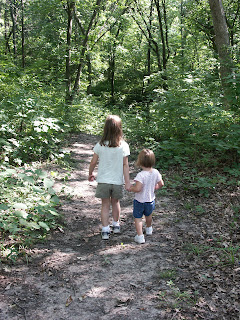Kids and Nature Go Hand in Hand
Stomping in mud puddles, digging in piles of dirt, swinging
on a tire swing, catching fireflies, picking vegetable from the garden…… these
are all ways kids and nature go hand in hand. The outdoors provides an exciting
place for kids to play, explore, observe, discover, and be challenged. Yet, in
today’s modern world, kids are increasingly disconnected with nature. I recently asked a 7-yr. old boy what he liked
about nature. He replied, “I don’t know… there isn’t any nature nearby.” Kids
believe that nature can only be found in a state park or vacation spot, and not
in their backyards and community green spaces. In the past, kids spent hours
playing in their yard or running around the neighborhood. Today, kids spend a
lot of their time indoors using a variety of modern technologies. Technology
can be useful when used appropriately but often these technologies give kids false
perceptions of the world. The best way for kids to understand and begin to care
about the environment is to get out and enjoy it!
There are many ways to engage kids in nature. First of all,
do it yourself! Kids who see adults engaging in nature and enjoying outside
activities are more likely to participate too.
Ideas for family play:
1.
Backyard campout – With the bugs and the summer
heat gone, this is a great time a year to pitch a tent in the yard. Kids can
listen for night sounds and guess what animals are active at night.
2.
Picnic – Kids love to eat outside! Throw a
blanket on the grass and enjoy a meal together. Talk about what other animals
eat and where they might “picnic”!
3.
Campfire – Cool fall evenings are best spent
around a campfire. Roast marshmallows, sing songs, tell stories, and gaze up at
the night sky.
4.
Dig in the dirt – Plant colorful mums or a tree
in the yard. Dig out the vegetable garden and prepare the area for next season.
Use leftover vegetables to start a compost pile.
5.
Nature Hike – Walk around the yard or
neighborhood a few times a week to notice new things. Look for different fall
colors, squirrels gathering acorns, and what birds are still in the area.
6.
Scavenger hunt – Kids love searching for things!
Make lists with words or pictures and see how many different things kids can
find in their yard. Kids will discover diversity in their own backyard.
7.
Feed the birds – The fall and winter season is a
great time to start feeding birds.
Collect pine cones, cover then with peanut butter, and roll then in bird
seed. Hang them up in trees in the yard and watch our feathery friends find a
treat!
8.
Visit an apple orchard or pumpkin farm – Talk
with kids about harvest time. Kids can help bake treats using apples or
pumpkins. Pumpkins can be used for decoration and then added to the compost
pile after Halloween.
9.
Rake leaves – Kids will have fun and get lots of
exercise raking the leaves. After the leaves are in big piles, let the kids
jump in. Talk about why leaves are so important to a tree and why trees lose
them in the fall.
10.
Nature journal – Kids like to express themselves
with pictures and words. Provide kids a small, booklet of paper and have them
find a quiet place in the yard. Kids can record what they hear, see, smell and
experience in their journals.
For more ideas on how to connect kids to nature, visit http://www.plt.org/-every-student-learns-outside.







